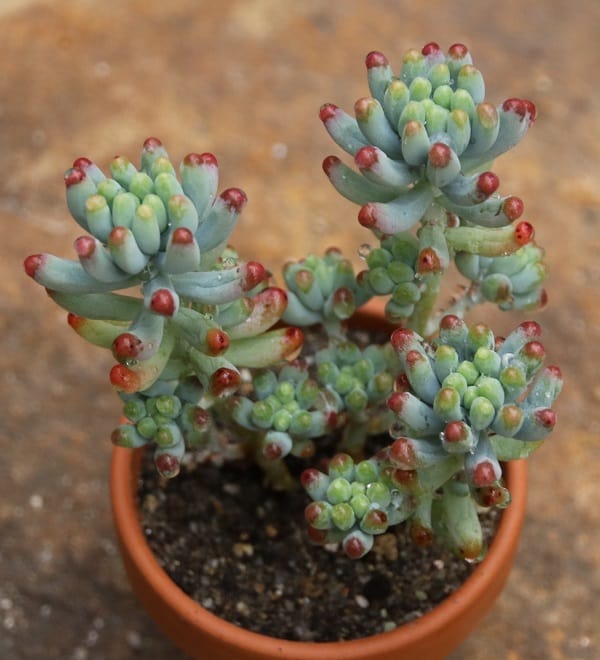Sedum Pachyphyllum also called Jelly Beans, Many Fingers or Blue Jelly Beans is a succulent, whose origin is from Oaxaca, Mexico.
The Sedum pachyphyllum form a compact plant of erect growth, about 20 cm high.
The stems are covered with thick, cylindrical, fleshy leaves and very close together.
The foliage of the jelly beans has a bluish-green color, the tips of the leaves take on a reddish hue, more intense in winter or when is exposed to direct sun.
And they form star-shaped cluster flowers, with five tips and yellow in color.
Tips to take care of the Sedum Pachyphyllum
Temperature
Like most succulents, jelly beans does not tolerate very low temperatures.
The minimum temperature this plant tolerates is approximate -6 ° C.
That is why you should be careful with the plant if in the place you live the temperature reaches a lower temperature.
Illumination
For the Sedum Pachyphyllum to develop correctly, it is essential to place it in a place where it receives a direct sun all year round.
You should only take care of the plant during the sunniest days of summer, and in that case, you can put it in partial shade.
If you plant the Jelly Beans in a pot inside your home, you should look for a very bright place, so that the plant can grow perfectly.
Irrigation
The Sedum Pachyphyllum are very susceptible to excess water and can rot the roots of the plant.
That is why you must take care of the irrigation of the plant, you must ensure that the substrate is completely dry between irrigation and irrigation.
Substratum
he incredible thing about sedum pachyphyllum is that it can grow in soils on poor or rocky soils.
So you can perfectly use a substrate made specifically for succulent plants and cacti.
Fertilizer
This plant is paid very sporadically during the summer, with a cactus fertilizer especially following the instructions on the fertilizer packaging.
Flowering period
The sedum pachyphyllum blooms in springtime.
Propagation
If you want to plant more sedum plants, you should only extract stem cuttings, then let the cutting form a callus for a couple of days, then you must plant the cuttings on a specific cactus substrate.
Plagues and diseases
The sedum pachyphyllum can be attacked by mealybugs, aphids and mollusks (snails and slugs).
The mealybugs and aphids are generally arranged at the junctions of the leaves with the stems.
Molluscs can devour the apex of the stems or leaf fragments in a few hours.
To cure the plant you should only buy a special insecticide for cacti.
Another problem that can attack the plant is the excess of water, which can cause the plant to become entangled, so it is important to follow the advice we give to water it.
Pruning
The sedum pachyphyllum does not need to be pruned.
Only in the case of any of its leaves are mistreated or damaged, in that case, you should only cut the damaged leaves so that the plant looks more aesthetic.
Curiosities of the plant:
The leaves of the sedum pachyphyllum fall off easily when the plant is touched without care.
But this discount becomes an advantage since when some leaflets fall into carelessness when handling it, it can be used as cuttings, to obtain a new plant if you follow the propagation steps mentioned above.
An important fact of sedum pachyphyllum can be toxic to animals, but only if animals ingest it, so you should keep this in mind if you have animals in your home.
